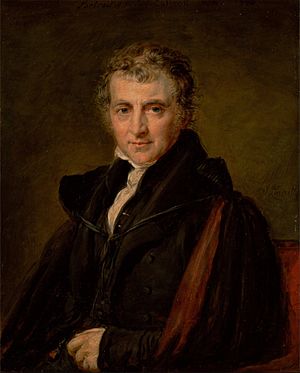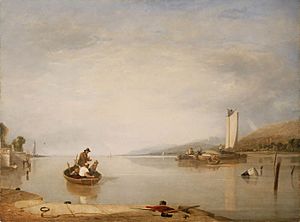Augustus Wall Callcott facts for kids
Quick facts for kids
Augustus Wall Callcott
|
|
|---|---|
 |
|
| Born | 20 February 1779 |
| Died | 25 November 1844 (aged 65) |
| Alma mater | Royal Academy Schools |
| Style | landscape art |
| Spouse(s) | Maria Graham |
| Elected | Royal Academy of Arts |
Sir Augustus Wall Callcott RA (born February 20, 1779 – died November 25, 1844) was a famous English artist. He was especially known for painting beautiful landscapes. These often showed scenes from nature, like rivers and coastlines.
Contents
Becoming a Famous Painter
Augustus Callcott was born in a village called Kensington Gravel Pits. This area is now part of Notting Hill Gate in London. First, Augustus studied music. He even sang in the choir at Westminster Abbey for several years.
When he was twenty, he decided to stop music and become an artist. He joined the Royal Academy of Arts as a student. There, he learned to paint portraits from a teacher named John Hoppner. His first painting, a portrait of Miss Roberts, was shown in 1799. Its success helped him choose painting as his career.
Painting Landscapes
Augustus soon found he loved painting landscapes the most. These included scenes of rivers and the coast. After 1804, he only showed landscape paintings for many years. People admired his skill and the beautiful look of his art. His fame grew steadily.
In 1806, he became an associate of the Royal Academy. By 1810, he was a full Academician. This meant he was a recognized and important artist. He took great care with his paintings, so he didn't make too many.
Between 1805 and 1810, he showed about four paintings each year. In 1811, he showed ten, and in 1812, six. From 1812 to 1822, he showed only seven works in total. But some of these were his best and largest. Examples include The Entrance to the Pool of London (1816) and A Dead Calm on the Medway (1820). Another important work was Rochester (1824).
Travels and New Inspiration
Until this time, Augustus usually painted scenes from England. But he had visited France and the Netherlands. He even painted some Dutch and Flemish scenes before 1827. In 1827, he got married and traveled to Italy for the first time.
His wife, Maria Graham, was already a well-known writer. She wrote about art and travel. After their trip to Italy, they lived in Kensington Gravel Pits. Augustus was very popular there until he passed away.
From 1830, he started showing paintings inspired by Italy. After this, he often painted foreign scenes. His later works were still charming and beautifully made. However, many people today think his paintings from before 1827 are his best.
Royal Recognition and Later Works
When Queen Victoria became queen in 1837, Augustus Callcott was honored with knighthood. This meant he became "Sir Augustus."
In 1837, he tried something different. He painted Raffaelle and the Fornarina, which showed life-sized people. He worked very carefully on this painting. Another important painting with people was Milton dictating to his Daughters (1840).
The Victoria and Albert Museum in London has some of his paintings with people. These include Anne Page and Slender and Falstaff and Simple. The museum also has many of his oil landscapes and watercolor sketches.
Augustus often included people in his landscape paintings. These figures were always well-designed and placed perfectly. An example is Dutch Peasants returning from Market.
In 1843, Sir Augustus Callcott became the Surveyor of the Queen's Pictures. This important job meant he looked after the Queen's art collection. He passed away on November 25, 1844. He was buried in Kensal Green Cemetery.
Other famous artists, like J. M. W. Turner, admired Augustus Callcott's work. He was also kind and supportive to younger artists.
Family
His wife, Maria Graham, was a writer who wrote about art and travel. His brother, John Wall Callcott, was a well-known composer (someone who writes music).


